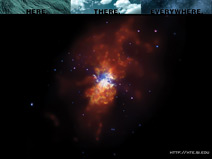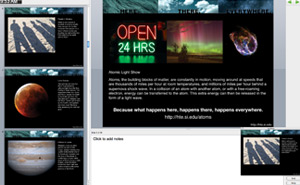


- MAKE YOUR OWN EXHIBIT
- WATCH A VIDEO
- READ A BLOG
- TACTILE & BRAILLE HTE
- AMERICAN SPACES
- PIN SOME IMAGES
- SHARE WITH A FRIEND

Topics: where the wind blows.
Winds can move particles from one place to another. A wind can occur wherever a difference in pressure between two locations is not balanced by some other force such as gravity. On Earth, winds can blow briefly
during a storm, and over long time scales, as in the jet stream. Winds have also been detected on other planets, in interplanetary space as the solar wind, around stars (stellar winds), and in galaxies.

- Dandelion.
- Feeling the wind blow and seeing its effects are very common experiences on Earth. Here, the seeds of a dandelion are distributed over a field by a gentle breeze. If particles are light enough, winds can suspend them and even scatter them aloft as smog, or the dust spread over long distances in the atmosphere after volcanic eruptions.
- Image: Stock Photography
- Comet Tail.
- The solar wind, a stream of charged particles flowing off the Sun, was discovered by observing comet tails. Comets have two tails: one that is mainly dust, and another that is composed of charged atoms, or ions. The ion tail is always pointing directly away from the Sun, no matter which way the comet itself is going. This is because the solar wind forces the ion tail to point in the direction where the solar wind is heading. The dust tail is composed of heavier particles that are less affected by the solar wind, and generally points away from the motion of the comet.
- Image: Visible Light: Dan Schechter
- Galactic Winds.
- In some galaxies, stars are forming at a furious rate. The most massive of these stars explode as supernovas only a few million years after they are formed. The combined effects of many supernova shock waves drives a galactic superwind, blowing gas out of the galaxy. These superwinds were likely the main way that carbon, nitrogen, oxygen, iron and other heavy elements formed in supernovas were spread throughout the Universe.
- Image: X-ray light: NASA/CXC/Wesleyan/R.Kilgard et al.
Where can we observe particles blowing in the wind?
On Earth, in the solar system, and in interstellar space - anywhere that differences in pressure
have set a gas in motion.
Related Resources

"Here, There, & Everywhere" (HTE) is supported by the National Aeronautics and Space Administration under grant NNX11AH28G issued through the Science Mission Directorate.
HTE was developed by the Chandra X-ray Center, at the Smithsonian Astrophysical Observatory, in Cambridge, MA.
Email: cxcpub@cfa.harvard.edu | Phone: 617.496.7941
Follow us: #HTEScience on Twitter






